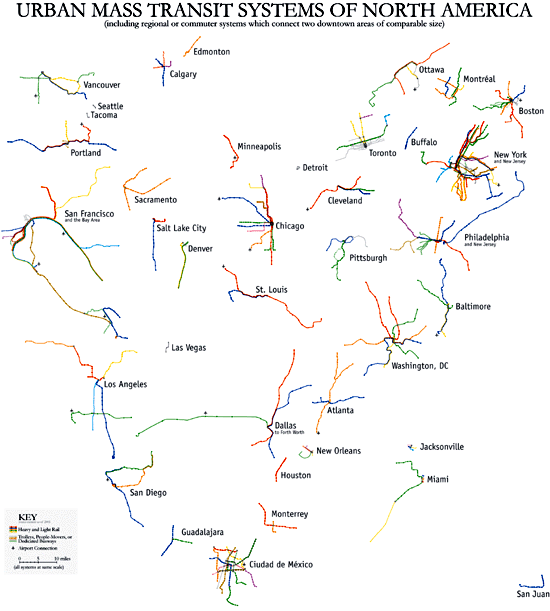via RADICAL CARTOGRAPHY
in the archive: see subways in scale
Tuesday, August 25, 2009
Friday, July 10, 2009
portrait - STEINBRENER/DEMPF
 Trouble in Paradise - A sunken car wreck at the rhinos, railroad tracks in the bison pen or toxic waste in the aquarium are unexpectedly interfering with our notions of idyllic wildlife. Trouble in Paradise is a temporary irritating installation in the Viennese Zoo by artists Steinbrener/Dempf.
Trouble in Paradise - A sunken car wreck at the rhinos, railroad tracks in the bison pen or toxic waste in the aquarium are unexpectedly interfering with our notions of idyllic wildlife. Trouble in Paradise is a temporary irritating installation in the Viennese Zoo by artists Steinbrener/Dempf.


 In large part, the Austrian artists deal with perception of public space. They got great attention back in 2005 with the temporary installation DELETE!, where they 'erased' any advertisment, sign, slogan, pictogram, company name in a prominent Viennese shopping street. A phenomenon we are sufficiently familar with from two-dimensional representations and photomontage works was translated f into three-dimensionality. Delettering the Public Space.
In large part, the Austrian artists deal with perception of public space. They got great attention back in 2005 with the temporary installation DELETE!, where they 'erased' any advertisment, sign, slogan, pictogram, company name in a prominent Viennese shopping street. A phenomenon we are sufficiently familar with from two-dimensional representations and photomontage works was translated f into three-dimensionality. Delettering the Public Space.




::: all images via Steinbrener/Dempf
Labels:
art,
SPATIALITIES
Wednesday, July 8, 2009
GIBELLINA II
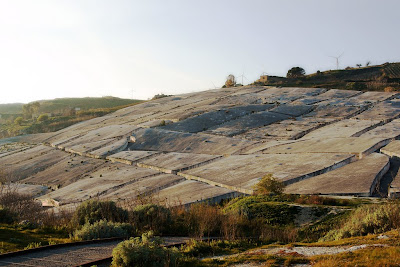 :: image via Flickr user charlesbegniamino
:: image via Flickr user charlesbegniaminoThanks to a post by mammoth this is a follow up to Synchronicity's Gibellina entry from May with links to awesome pictures of Alberto Burri’s Grande Cretto and the other artworks of Gibellina.
Grande Cretto
Gibellina 1
Gibellina 2
Gibellina art
In the Archives: Gibellina
Labels:
art,
post-human,
TERRITORIES,
URBANITIES
Thursday, June 11, 2009
PARI(S) PLUS PETIT
The project Paris Plus petit by MVRDV in collaboration with ACS and AAF is one of ten proposals by international architecture and urbanism teams to envision the future of the French capital and its vast agglomeration. The urban challenge has been commissioned by French president Nicolas Sarkozy.
Labels:
globalwarming,
URBANITIES
Thursday, June 4, 2009
! MAP THIS ! #15 TIME-LAPSE VIDEOS OF MASSIVE CHANGE ON EARTH
Sucking Out The Aral Sea:
or Clearing the Amazon
Over the past decade, the number of people on Earth shot up by more than 13 percent, to nearly 6.8 billion people. To make room for all the hungry, breeding, CO2-emitting bodies on our small planet, we’ve ravaged Earth’s surface with staggering feats of deforestation, irrigation and urbanization — and NASA satellites have captured it all. The videos shown above (and a few more on Wired) are compiled from images posted on NASA’s Earth Observatory, of some of the most impressive conquests of man over environment.
Labels:
environment,
mapoftheweek,
URBANITIES
Sunday, May 31, 2009
TRAFFIC!

The French writer and philosopher Jean Baudrillard once wrote of the freeways of Los Angeles as being "ideally suited to the only truly profound pleasure, that of keeping on the move." Indeed, nowhere is the pleasure of keeping on the move more profound than in a city whose freeways rarely offer it.Architecture photographer Benny Chan documents Los Angeles' traffic problems. Shot over a few years during various helicopter trips, the photographs give information about the extents of LA's car problem.

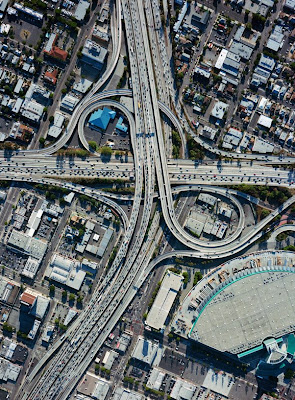




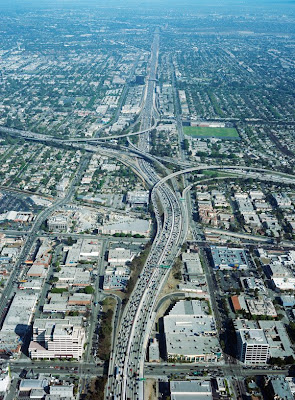


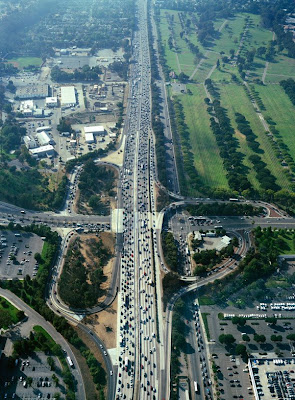
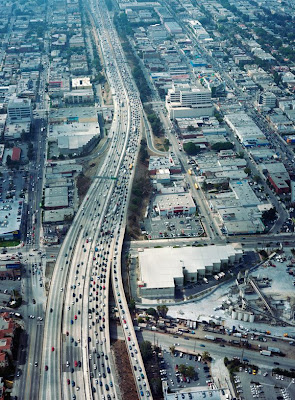 :: images and quote via GOOD Magazine
:: images and quote via GOOD Magazine
Labels:
infrastructure,
SPATIALITIES,
TERRITORIES
Sunday, May 10, 2009
GIBELLINA
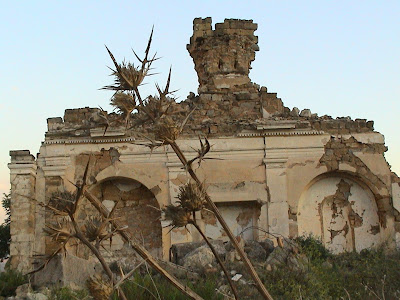 In 1968, the small town of Gibellina, Sicily was completely destroyed by an earthquake. And only a few years later rebuilt close to the original site. The erection of the new Gibellina was supported by a unique vision: against traditional forces of bureaucracy, corrupt politics and Sicilian mafia. Artists were invited to design buildings and sculptures and to incorporate place and landscape into their work. After a short period of florescence, Gibellina of today resembles a ghost town.
In 1968, the small town of Gibellina, Sicily was completely destroyed by an earthquake. And only a few years later rebuilt close to the original site. The erection of the new Gibellina was supported by a unique vision: against traditional forces of bureaucracy, corrupt politics and Sicilian mafia. Artists were invited to design buildings and sculptures and to incorporate place and landscape into their work. After a short period of florescence, Gibellina of today resembles a ghost town. :Butterfly shaped new Gibellina
:Butterfly shaped new GibellinaAfter the earthquake, a history of 900 years was destroyed, but not only the buildings were damaged also the people and their communities. Hence after the catastrophe there should be a new very unique Gibellina, art should reconcile the people. Urbanism from scratch should create the new home. Promoted by the charismatic mayor Ludovico Corrao, who wanted the best for his people, now four decades later the experiment failed. The butterfly shaped new Gibellina is dead. People could not find a new home in the modernistic structure. The community was destroyed. At the beginning of the 80's 8000 people lived there. Today there are only 4500. Young people went away, to Milan, Torino or America. The grand scale Piazze and streets are all empty. An inhabitant: "This town is a stranger in its own environment. A town with enormous amount of space - and enormous disconsolation."
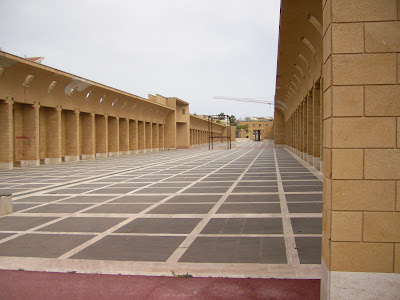

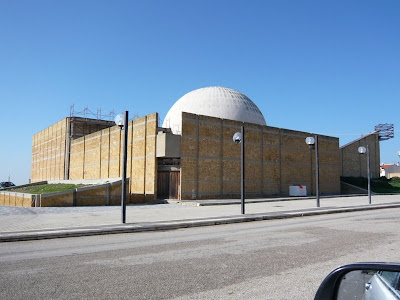

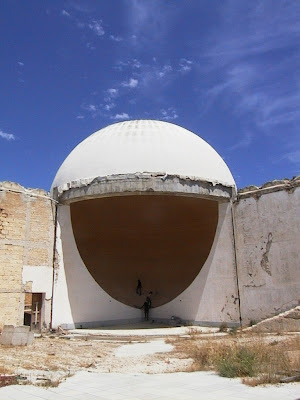
 Corrao wanted to create a modern contemporary Gibellina, completed with all kinds of sculptures and artwork. This should create a touristic attraction and therefore bring money to a town in a poor area of Italy. Huge metal sculptures, now rusty, giant stars spanning over streets, vast open spaces. A small town with no soul. The experiment failed. But blaming art for that failure would be too easy. Gibellina is an example where modern architecture and urbanism failed.
Corrao wanted to create a modern contemporary Gibellina, completed with all kinds of sculptures and artwork. This should create a touristic attraction and therefore bring money to a town in a poor area of Italy. Huge metal sculptures, now rusty, giant stars spanning over streets, vast open spaces. A small town with no soul. The experiment failed. But blaming art for that failure would be too easy. Gibellina is an example where modern architecture and urbanism failed.







 Probably the only still 'functioning' piece of art is situated at the area where the old town once was located. In 1981 Italian artist Alberto Burri erected an enormous monument out of concrete. The former blocks were waist-high monoliths, in-between the old layout of the streets.
Probably the only still 'functioning' piece of art is situated at the area where the old town once was located. In 1981 Italian artist Alberto Burri erected an enormous monument out of concrete. The former blocks were waist-high monoliths, in-between the old layout of the streets.



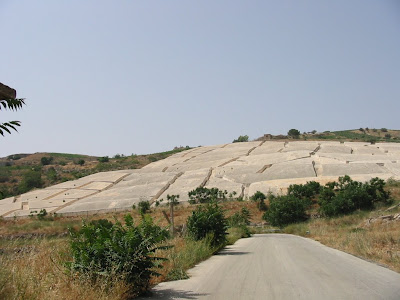
 Austrian filmmaker Juergen Burger tries to get hold of Gibellina in his documentary "Gibellina - Il terremoto". Trailer
Austrian filmmaker Juergen Burger tries to get hold of Gibellina in his documentary "Gibellina - Il terremoto". Trailer:: all images via GoogleEarth
Follow up: Gibellina II
Labels:
art,
modernism,
URBANITIES
Wednesday, April 15, 2009
PLEASE..
.. be patient and sorry for the lack of posts in the last couple of weeks.
But in may, SYNCHRONICITY will launch again at full force !! So watch out.
But in may, SYNCHRONICITY will launch again at full force !! So watch out.
Friday, February 13, 2009
...WHAT A WONDERFUL MORNING

This Otto Neurath inspired narrative is part of the work 'Book from the Ground' by Brooklyn based artist Xu Bing. He is even developing a computer programm that translates from different languages into the pictoral language of isotypes. Read the artist:
Book from the Ground is a novel written in a "language of icons" that I have been collecting and organizing over the last few years. Regardless of cultural background, one should be able understand the text as long as one is thoroughly entangled in modern life. We have also created a "font library" computer program to accompany the book. The user can type English sentences (we are still limited in this way, but the next step will include Chinese and other major languages) and the computer will instantaneously translate them into this language of icons. It can function as a "dictionary," and in the future it will have practical applications.
via ads without products
Labels:
excursus,
representation
Saturday, January 24, 2009
! MAP THIS ! #14 COMPLEXCITY
 The Complexcity project explores major cities around the world focussing on how their urban sprawls have evolved over time. Using the patterns formed by roads in each city, Korean born designer Lee Jang Sub creates complex graphic configurations, combining the idea of natural and man made systems. In the process he finds a concealed aesthetic within the convoluted pattern of urban networks. He started with his hometown Seoul, and has already completed Paris, Rome, and Moscow.
The Complexcity project explores major cities around the world focussing on how their urban sprawls have evolved over time. Using the patterns formed by roads in each city, Korean born designer Lee Jang Sub creates complex graphic configurations, combining the idea of natural and man made systems. In the process he finds a concealed aesthetic within the convoluted pattern of urban networks. He started with his hometown Seoul, and has already completed Paris, Rome, and Moscow.Through this work, I would like to suggest they don't see the complexity of a city only as an object that should be neatly arranged. Instead I propose a new approach of finding order in the ComplexCity, Seoul.
Each one of branches in a big tree seems to be disorderly spreaded with no rules, but when you see the whole tree, you can find it is in perfect harmony. Nature has a balance which we cannot see with our vision. I created this tree with patterns of roads spontaneously developed in a city, Seoul. I could find the patterns in a map of Seoul which represents the complexity of the city.
 ::Seoul (image via Lee Jang Sub)
::Seoul (image via Lee Jang Sub) ::Paris (image via Lee Jang Sub)
::Paris (image via Lee Jang Sub) ::Moscow (image via Lee Jang Sub)
::Moscow (image via Lee Jang Sub) ::Rome (image via Lee Jang Sub)
::Rome (image via Lee Jang Sub) ::image via Lee Jang Sub
::image via Lee Jang Sub
Labels:
mapoftheweek
Subscribe to:
Posts (Atom)
